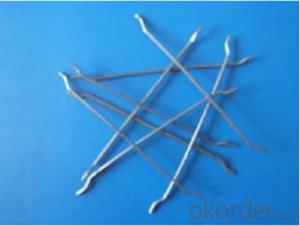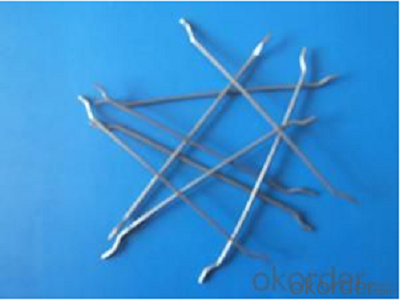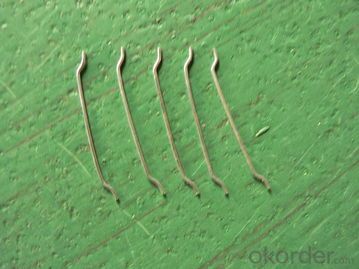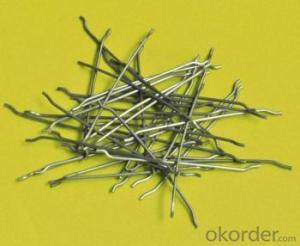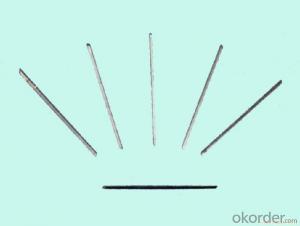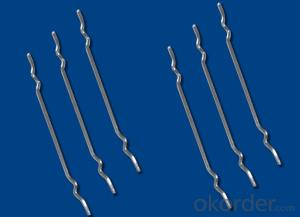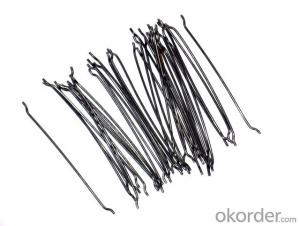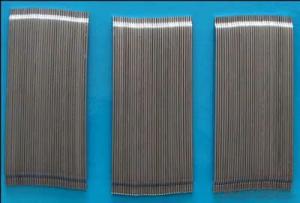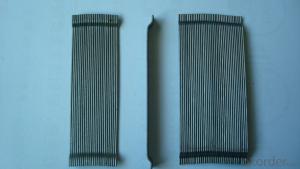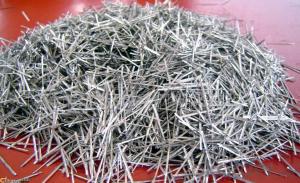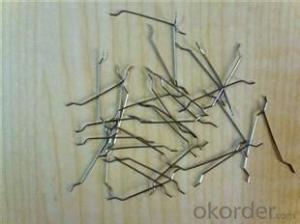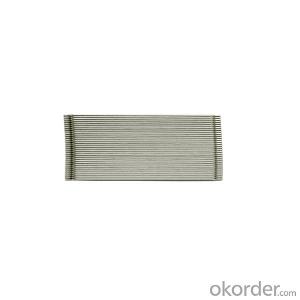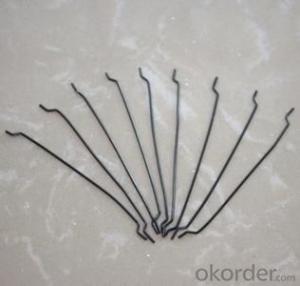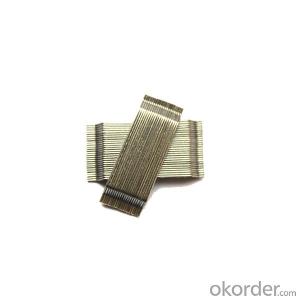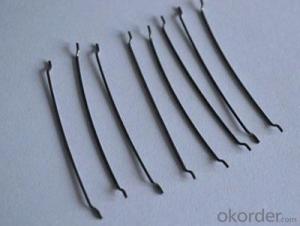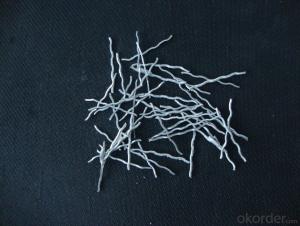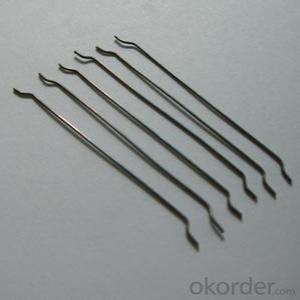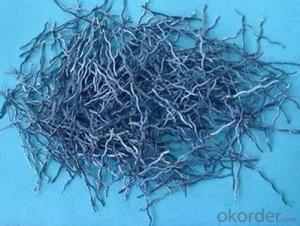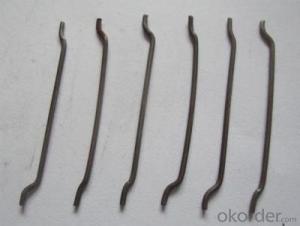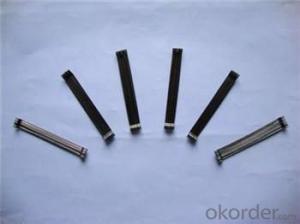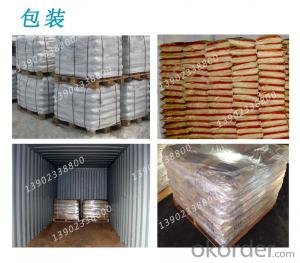Melt Extract Stainless Steel Fiber Reinforced Concrete Steel Fiber 0.9/55 from CNBM China
- Loading Port:
- Tianjin
- Payment Terms:
- TT or LC
- Min Order Qty:
- 1 m.t.
- Supply Capability:
- 5000 m.t./month
OKorder Service Pledge
OKorder Financial Service
You Might Also Like
Quick Details
Place of Origin: Tianjin, China (Mainland)
Model Number: 0.9
Material: Steel
Production Process: Cold drawn
Lengh: 55
Type: 1
Compressive Strength: >1200MPa
Aspect ratio: 61
Standard: ASTM A820M-11
Section Shape: Circular
Application: Concrete Reinforcement
Specifications
| Diameter | 0.90 | mm | 0.04 | in |
| Length | 55.00 | mm | 2.16 | in |
| Aspect Ratio | 61 | |||
| Tensile strength | 1200 MPa | |||
| Type | Cold drawn Steel Fiber | |||
| End | Hooked-end Steel Fiber | |||
| Glued/Loose | Glued Steel Fiber | |||
| Bending Angle | 45°(min.30°) | |||
| Usage & Performance | Floor:Trafficked areas and Industrial floors | |||
| Shotcrete :Slope stabilization and Final lining | ||||
| Precast concrete:Pipe and Railway sleepers | ||||
| Packing | Standard Export Pallet Packing | Bag Packing | 20 kg/Bag,50 bags/Pallet | |
| Bulk Packing | 1,000kg/ Bulk Bag | |||
| Loading Quantity | 20’GP | 20-25 Tonne/Tonnes | ||
| 40’GP | 25-27 Tonne/Tonnes | |||
| 40’HQ | 25-27 Tonne/Tonnes | |||
| MOQ | 1 kg for trial order | |||
| Supply Ability | 10,000 Tonne/Tonnes per Year | |||
| Payment Terms | T/T or L/C at sight | |||
| Delivery Time | Within 15 days after receiving deposit or original L/C at sight | |||
| Certification | ISO9001:2000, CE, | |||
| Product | Diameter | Length mm/in | Aspect Ratio | Type | Packing |
| G-6030 | 0.5 mm (0.0197 in) | 30 mm (1.1811 in) | 60 | Glued | 20 kg/Bag, or 1,000kg/ Bulk Bag |
| G-6535 | 0.55 mm (0.0217 in) | 35 mm (1.3780 in) | 65 | Glued | 20 kg/Bag, or 1,000kg/ Bulk Bag |
| G-6035 | 0.6 mm (0.0236 in) | 35 mm (1.3780 in) | 60 | Glued | 20 kg/Bag, or 1,000kg/ Bulk Bag |
| G-8060 | 0.75 mm (0.0295 in) | 60 mm (2.3622 in) | 80 | Glued | 20 kg/Bag, 50 bags/Pallet |
| G-6060 | 0.9 mm (0.0354 in) | 60 mm (2.3622 in) | 60 | Glued | 20 kg/Bag, 50 bags/Pallet |
| G-6030 | 0.5 mm (0.0197 in) | 30 mm (1.1811 in) | 60 | Loose | 20 kg/Bag, or 1,000kg/ Bulk Bag |
| G-6535 | 0.55 mm (0.0217 in) | 35 mm (1.3780 in) | 65 | Loose | 20 kg/Bag, or 1,000kg/ Bulk Bag |
| G-6035 | 0.6 mm (0.0236 in) | 35 mm (1.3780 in) | 60 | Loose | 20 kg/Bag, or 1,000kg/ Bulk Bag |
| G-8060 | 0.75 mm (0.0295 in) | 60 mm (2.3622 in) | 80 | Loose | 20 kg/Bag, 50 bags/Pallet |
| G-6060 | 0.9 mm (0.0354 in) | 60 mm (2.3622 in) | 60 | Loose | 20 kg/Bag, 50 bags/Pallet |
Picture
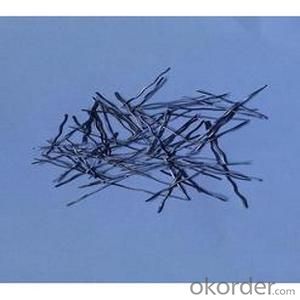
Steel fiber
FAQ
Technical advantages of Daye steel fiber:
A. Improve mechanical performance of concrete
B. Provide uniform distribution throughout concrete with excellent mixing
C. No balling or caking by adopt correct mixing method
D. Reduce concrete volume
E.Save construction time and cost
F.Reduce excavation volume
G.Available for jointless floor.
- Q: What is the effect of melt extract stainless steel fiber on the modulus of creep of concrete?
- Including melt extract stainless steel fibers in concrete has a favorable impact on the material's creep modulus. Stainless steel fibers are renowned for their excellent tensile strength, resistance to corrosion, and durability. When integrated into concrete, these fibers serve as reinforcement, thereby enhancing its mechanical characteristics. The creep modulus denotes the material's capacity to withstand deformation over a prolonged period under a consistent load. By incorporating stainless steel fibers, the concrete's resistance to creep is enhanced as the fibers aid in load distribution and reduction of internal stresses within the material. Consequently, the rate of creep diminishes and the creep modulus increases. Furthermore, the presence of melt extract stainless steel fibers also enhances the concrete's overall ductility. This implies that the material can endure greater deformation before experiencing failure, leading to improved structural stability and performance. This is particularly advantageous in situations where the concrete is subjected to sustained loads or temperature fluctuations, as it mitigates the risk of long-term deformation and potential structural failure. In conclusion, the inclusion of melt extract stainless steel fibers has a positive effect on the concrete's creep modulus. Their addition improves the material's resistance to deformation over time, enhances its mechanical properties, and augments its overall durability.
- Q: How does melt extract stainless steel fiber improve the impact resistance of bridge decks?
- The use of melt extract stainless steel fiber in bridge deck construction shows great promise in enhancing impact resistance. This material is produced by melting stainless steel and extracting it into fibers of varying lengths and diameters. These fibers are then incorporated into the concrete matrix during the construction process. The inclusion of melt extract stainless steel fiber in bridge decks offers numerous benefits that bolster their impact resistance. Firstly, the fibers serve as reinforcement within the concrete, establishing a three-dimensional network that boosts tensile strength and overall durability. This reinforcement effectively distributes load and impact forces, preventing the propagation of cracks and fractures that could compromise the integrity of the bridge deck. Furthermore, the distinctive properties of stainless steel, such as its high strength, corrosion resistance, and ductility, make it an ideal material for enhancing impact resistance in bridge decks. When subjected to impact or dynamic loading, the stainless steel fibers absorb and dissipate energy throughout the concrete matrix. This reduces stress concentration and minimizes the risk of damage. The energy absorption mechanism enables bridge decks to withstand heavy traffic, seismic events, and other external impacts. In addition, melt extract stainless steel fibers improve crack resistance in bridge decks. These fibers act as micro-reinforcements, inhibiting the formation and expansion of cracks. They bridge small cracks and prevent them from growing larger. This crack bridging effect not only enhances the overall durability of the bridge deck but also reduces the need for maintenance and extends the structure's service life. In conclusion, the use of melt extract stainless steel fiber in bridge deck construction is highly beneficial, greatly enhancing impact resistance. Through reinforcement of the concrete matrix, energy absorption and dissipation, and improved crack resistance, this material ensures the longevity and structural integrity of bridge decks, making them more resilient to a wide range of impacts.
- Q: Can melt extract stainless steel fiber be used in pre-stressed concrete applications?
- Indeed, in pre-stressed concrete applications, the utilization of melt extract stainless steel fiber is possible. Pre-stressed concrete is a concrete variant that gains strength through the application of internal stresses, achieved by tensioned steel wires or cables. By incorporating stainless steel fibers into pre-stressed concrete, an extra layer of reinforcement is provided, thus enhancing its mechanical properties. Melt extract stainless steel fibers are renowned for their remarkable tensile strength, resistance to corrosion, and durability, rendering them suitable for employment in pre-stressed concrete applications. Consequently, these fibers play a crucial role in augmenting the overall strength, crack resistance, and long-term performance of pre-stressed concrete structures.
- Q: What is the effect of melt extract stainless steel fiber on the modulus of elasticity of shotcrete?
- The incorporation of melt extract stainless steel fiber into shotcrete results in an augmentation of the material's modulus of elasticity, ultimately leading to an overall increase in stiffness and rigidity. This addition of stainless steel fibers aids in the enhancement of shotcrete's mechanical properties, including its modulus of elasticity. Stainless steel fibers possess notable tensile strength and exceptional corrosion resistance. When integrated into shotcrete, they establish a reinforcement network throughout the material, bolstering its capacity to withstand external forces and stresses. The modulus of elasticity quantifies a material's ability to deform when subjected to a load and subsequently return to its original shape after the load is removed. By introducing melt extract stainless steel fibers into shotcrete, the overall modulus of elasticity is elevated, rendering the shotcrete more resistant to deformation and imbuing it with heightened stiffness, thereby reducing its susceptibility to cracking and enhancing its structural integrity. Moreover, the inclusion of stainless steel fibers can also aid in the management and mitigation of shrinkage cracking in shotcrete, which is particularly crucial in applications where shotcrete functions as a structural element or serves as a lining material in underground constructions such as tunnels or mines. To summarize, the effect of melt extract stainless steel fiber on the modulus of elasticity of shotcrete is a substantial increase in stiffness and rigidity. This improvement in mechanical properties instills shotcrete with enhanced durability, diminished cracking, and improved structural performance across diverse construction settings.
- Q: Can melt extract stainless steel fiber be used in combination with other types of reinforcement?
- Yes, melt extract stainless steel fiber can be used in combination with other types of reinforcement in various applications. It can be combined with materials like concrete, polymers, or composites to enhance their mechanical properties, such as improved tensile strength, crack resistance, and durability. The addition of stainless steel fibers can provide synergistic effects and improve the overall performance of the reinforced material.
- Q: How does melt extract stainless steel fiber improve the fatigue resistance of concrete?
- The unique properties and characteristics of melt extract stainless steel fiber are well-known for enhancing the fatigue resistance of concrete. When added to concrete, these fibers create a reinforcement network that strengthens the material and improves its ability to withstand repetitive loading or cyclic stress. One way in which melt extract stainless steel fiber enhances the fatigue resistance of concrete is by increasing its crack resistance. As cyclic loading occurs, cracks can develop and spread, leading to failure. However, the presence of stainless steel fibers helps to stop the growth of these cracks, preventing them from spreading and improving the overall durability of the concrete. In addition, the high tensile strength and excellent ductility of stainless steel fibers contribute to the fatigue resistance of concrete. These fibers can absorb and distribute stress throughout the concrete matrix, reducing stress concentration. This redistribution of stress helps to prevent the formation of microcracks and enhances the overall fatigue strength of the concrete. Furthermore, the corrosion resistance of stainless steel fibers plays a crucial role in improving the fatigue resistance of concrete. Concrete is often exposed to harsh environmental conditions, such as moisture and chemicals, which can lead to corrosion and deterioration. However, stainless steel fibers are highly resistant to corrosion, ensuring the long-term integrity and durability of the concrete structure. Moreover, melt extract stainless steel fibers also provide thermal stability to concrete. Temperature variations can cause concrete to expand and contract, leading to cracks and reducing fatigue resistance. However, the presence of stainless steel fibers helps to minimize these thermal stresses by providing additional reinforcement and reducing the risk of crack formation. In conclusion, melt extract stainless steel fiber enhances the fatigue resistance of concrete through multiple mechanisms. It improves crack resistance, distributes stress, offers corrosion resistance, and provides thermal stability. By incorporating these fibers into concrete, the material becomes more resilient, durable, and capable of withstanding repetitive loading or cyclic stress, ultimately improving its fatigue resistance.
- Q: Can melt extract stainless steel fiber improve the impact resistance of concrete?
- Concrete's impact resistance can be improved by the use of melt extract stainless steel fiber. These fibers are known for their high tensile strength, which boosts the overall durability and toughness of the concrete. By adding these fibers to the concrete mix, they act as reinforcement and prevent cracks from spreading when subjected to impacts or dynamic loads. The steel fibers help distribute stress evenly throughout the concrete, reducing the chances of brittle failure and increasing impact resistance. Furthermore, the melt extract stainless steel fibers have a high aspect ratio, being long and thin, which further enhances their ability to improve impact resistance. Incorporating these fibers into concrete significantly enhances its ability to withstand impacts and dynamic loads, making it a preferred choice for applications where impact resistance is crucial, such as industrial flooring, pavements, and high load-bearing structural elements.
- Q: Can melt extract stainless steel fiber improve the resistance of concrete to fire?
- Certainly, the incorporation of melt extract stainless steel fiber into concrete has the ability to enhance its fire resistance. Renowned for their elevated melting point, resistance to corrosion, and exceptional heat conductivity, stainless steel fibers are an optimal choice for bolstering the fire resistance of concrete. Upon their addition to concrete, these fibers establish a three-dimensional reinforcement network, effectively preventing the occurrence of cracks and spalling during exposure to fire. Furthermore, the stainless steel fibers serve as a heat sink, proficiently absorbing and dissipating heat, thus significantly impeding the rise in temperature within the concrete and consequently augmenting its fire resistance. Moreover, these fibers fortify the concrete's overall strength and durability, rendering it more resilient to fire and extending its structural integrity even under extreme temperatures. Consequently, the inclusion of melt extract stainless steel fiber in concrete unquestionably improves its resistance to fire.
- Q: How does melt extract stainless steel fiber affect the fire resistance of concrete?
- Melt extract stainless steel fiber significantly enhances the fire resistance of concrete. When added to concrete, these fibers create a three-dimensional network that improves the material's ability to withstand high temperatures and prevent cracking. As the concrete heats up during a fire, the stainless steel fibers act as a reinforcement, reducing spalling and maintaining the structural integrity of the concrete. Additionally, these fibers increase the thermal conductivity of the concrete, allowing heat to dissipate more efficiently and reducing the risk of thermal shock. Overall, the addition of melt extract stainless steel fiber greatly improves the fire resistance and durability of concrete structures.
- Q: Does melt extract stainless steel fiber improve the resistance to sulfate attack of shotcrete?
- Yes, melt extract stainless steel fiber does improve the resistance to sulfate attack of shotcrete. Sulfate attack occurs when sulfates from the environment penetrate the concrete and react with the calcium hydroxide in the cement paste, leading to the formation of expansive products that can cause cracking and deterioration of the concrete. Shotcrete, a form of concrete that is sprayed onto surfaces, is particularly susceptible to sulfate attack due to its higher water-cement ratio and reduced curing time. Melt extract stainless steel fiber is a type of reinforcement that is added to shotcrete to enhance its mechanical properties and durability. The inclusion of stainless steel fibers in shotcrete significantly improves its resistance to sulfate attack. Stainless steel fibers have high tensile strength and excellent corrosion resistance, making them ideal for applications in aggressive environments such as those with high sulfate concentrations. These fibers act as reinforcement in the shotcrete, reducing the potential for cracking and providing enhanced resistance to sulfate attack. Furthermore, melt extract stainless steel fibers have a unique microstructure that promotes bonding with the cement matrix, improving the overall performance of the shotcrete. The interaction between the stainless steel fibers and the cementitious matrix creates a more robust and durable material, capable of withstanding the detrimental effects of sulfate attack. In conclusion, the addition of melt extract stainless steel fiber to shotcrete improves its resistance to sulfate attack. The high tensile strength, corrosion resistance, and bonding properties of stainless steel fibers contribute to the overall durability and longevity of shotcrete in sulfate-rich environments.
Send your message to us
Melt Extract Stainless Steel Fiber Reinforced Concrete Steel Fiber 0.9/55 from CNBM China
- Loading Port:
- Tianjin
- Payment Terms:
- TT or LC
- Min Order Qty:
- 1 m.t.
- Supply Capability:
- 5000 m.t./month
OKorder Service Pledge
OKorder Financial Service
Similar products
Hot products
Hot Searches
Related keywords
